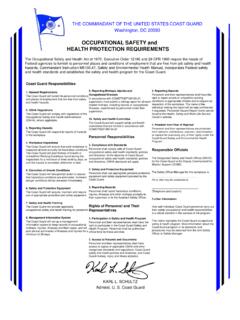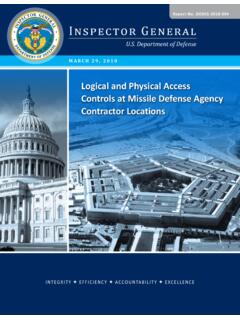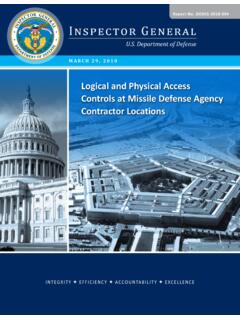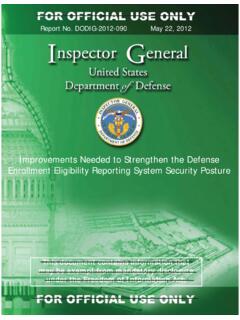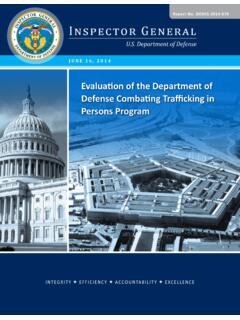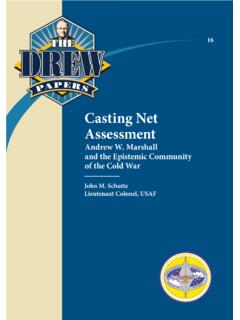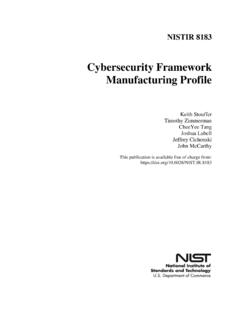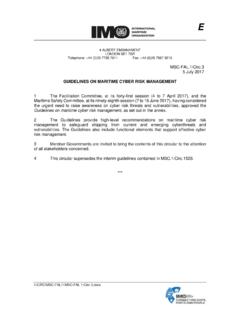Transcription of Kubernetes Hardening Guide
1 National Security Agency cybersecurity and Infrastructure Security Agency cybersecurity Technical Report Kubernetes Hardening Guide March 2022. U/OO/168286-21. PP-22-0324. Version National cybersecurity Security Agency and Infrastructure Security Agency Kubernetes Hardening Guidance Notices and history Document change history Date Version Description August 2021 Initial release March 2022 Updated guidance based on industry feedback Disclaimer of warranties and endorsement The information and opinions contained in this document are provided "as is" and without any warranties or guarantees. Reference herein to any specific commercial products, process, or service by trade name, trademark, manufacturer, or otherwise, does not necessarily constitute or imply its endorsement, recommendation, or favoring by the United States Government, and this Guide shall not be used for advertising or product endorsement purposes.
2 Trademark recognition Kubernetes is a registered trademark of The Linux Foundation. SELinux is a registered trademark of the National Security Agency. AppArmor is a registered trademark of SUSE LLC. Windows and Hyper-V are registered trademarks of Microsoft Corporation. ETCD is a registered trademark of CoreOS, Inc. Syslog-ng is a registered trademark of One Identity Software International Designated Activity Company. Prometheus is a registered trademark of The Linux Foundation. Grafana is a registered trademark of Raintank, Inc. dba Grafana Labs Elasticsearch and ELK Stack are registered trademarks of Elasticsearch Copyright recognition Information, examples, and figures in this document are based on Kubernetes Documentation by The Kubernetes Authors, published under a Creative Commons Attribution license. Acknowledgements NSA and CISA acknowledge the feedback received from numerous partners and the cybersecurity community on the previous version of this report, and thank them for their help in making it better.
3 Changes have been incorporated where appropriate. U/OO/168286-21 | PP-22-0324 | March 2022 Ver. i National cybersecurity Security Agency and Infrastructure Security Agency Kubernetes Hardening Guidance Publication information Author(s). National Security Agency (NSA). cybersecurity Directorate Endpoint Security cybersecurity and Infrastructure Security Agency (CISA). Contact information Client Requirements / General cybersecurity Inquiries: cybersecurity Requirements Center, 410-854-4200, Media inquiries / Press Desk: Media Relations, 443-634-0721, For incident response resources, contact CISA at Purpose NSA and CISA developed this document in furtherance of their respective cybersecurity missions, including their responsibilities to develop and issue cybersecurity specifications and mitigations. This information may be shared broadly to reach all appropriate stakeholders.
4 U/OO/168286-21 | PP-22-0324 | March 2022 Ver. ii National cybersecurity Security Agency and Infrastructure Security Agency Kubernetes Hardening Guidance Executive summary Kubernetes is an open-source system that automates the deployment, scaling, and management of applications run in containers, and is often hosted in a cloud environment. Using this type of virtualized infrastructure can provide several flexibility and security benefits compared to traditional, monolithic software platforms. However, securely managing everything from microservices to the underlying infrastructure introduces other complexities. This report is designed to help organizations handle Kubernetes -associated risks and enjoy the benefits of using this technology. Three common sources of compromise in Kubernetes are supply chain risks, malicious threat actors, and insider threats.
5 Supply chain risks are often challenging to mitigate and can arise in the container build cycle or infrastructure acquisition. Malicious threat actors can exploit vulnerabilities and misconfigurations in components of the Kubernetes architecture, such as the control plane, worker nodes, or containerized applications. Insider threats can be administrators, users, or cloud service providers. Insiders with special access to an organization's Kubernetes infrastructure may be able to abuse these privileges. This Guide describes the security challenges associated with setting up and securing a Kubernetes cluster. It includes strategies for system administrators and developers of National Security Systems, helping them avoid common misconfigurations and implement recommended Hardening measures and mitigations when deploying Kubernetes .
6 This Guide details the following mitigations: Scan containers and Pods for vulnerabilities or misconfigurations. Run containers and Pods with the least privileges possible. Use network separation to control the amount of damage a compromise can cause. Use firewalls to limit unneeded network connectivity and use encryption to protect confidentiality. Use strong authentication and authorization to limit user and administrator access as well as to limit the attack surface. Capture and monitor audit logs so that administrators can be alerted to potential malicious activity. Periodically review all Kubernetes settings and use vulnerability scans to ensure risks are appropriately accounted for and security patches are applied. U/OO/168286-21 | PP-22-0324 | March 2022 Ver. iii National cybersecurity Security Agency and Infrastructure Security Agency Kubernetes Hardening Guidance For additional security Hardening guidance, see the Center for Internet Security Kubernetes benchmarks, the Docker and Kubernetes Security Technical Implementation Guides, the cybersecurity and Infrastructure Security Agency (CISA).
7 Analysis report, and Kubernetes documentation [1], [2], [3], [6]. U/OO/168286-21 | PP-22-0324 | March 2022 Ver. iv National cybersecurity Security Agency and Infrastructure Security Agency Kubernetes Hardening Guidance Contents Kubernetes Hardening Guide .. i Executive summary .. iii Contents .. v Introduction .. 1. 2. Architectural overview .. 4. Threat model .. 6. Kubernetes Pod security .. 8. Non-root containers and rootless container engines .. 9. Immutable container file systems .. 10. Building secure container images .. 10. Pod security enforcement .. 12. Protecting Pod service account tokens .. 12. Hardening container environments .. 13. Network separation and Hardening .. 14. Namespaces .. 14. Network policies .. 15. Resource policies .. 17. Control plane Hardening .. 18. Etcd .. 19. Kubeconfig Files .. 19.
8 Worker node segmentation .. 19. Encryption .. 20. Secrets .. 20. Protecting sensitive cloud infrastructure .. 21. Authentication and authorization .. 22. 22. Role-based access control .. 23. Audit Logging and Threat Detection .. 27. Logging .. 27. Kubernetes native audit logging configuration .. 29. Worker node and container logging .. 30. Seccomp: audit mode .. 32. Syslog .. 32. SIEM platforms .. 33. Service meshes .. 34. Fault tolerance .. 35. Threat Detection .. 36. Alerting .. 37. Tools .. 38. Upgrading and application security practices .. 40. Works cited .. 41. U/OO/168286-21 | PP-22-0324 | March 2022 Ver. v National cybersecurity Security Agency and Infrastructure Security Agency Kubernetes Hardening Guidance Appendix A: Example Dockerfile for non-root application .. 42. Appendix B: Example deployment template for read-only file system.
9 43. Appendix C: Pod Security Policies (deprecated) .. 44. Appendix D: Example Pod Security Policy .. 46. Appendix E: Example namespace .. 48. Appendix F: Example network policy .. 49. Appendix G: Example LimitRange .. 50. Appendix H: Example ResourceQuota .. 51. Appendix I: Example encryption .. 52. Appendix J: Example KMS configuration .. 53. Appendix K: Example pod-reader RBAC Role .. 54. Appendix L: Example RBAC RoleBinding and 55. Appendix M: Audit Policy .. 57. Appendix N: Example Flags to Enable Audit Logging .. 59. Figures Figure 1: High-level view of Kubernetes cluster components .. 1. Figure 2: Kubernetes architecture .. 4. Figure 3: Example of container supply chain dependencies introducing malicious code into a cluster .. 7. Figure 4: Pod components with sidecar proxy as logging 9. Figure 5: A hardened container build workflow.
10 11. Figure 6: Possible Role, ClusterRole, RoleBinding, and ClusterRoleBinding combinations to assign access ..25. Figure 7: Cluster leveraging service mesh to integrate logging with network Tables Table I: Control plane Table II: Worker node ports ..20. Table III: Remote logging configuration ..31. Table IV: Detection recommendations ..36. Table V: Pod Security Policy components ..44. U/OO/168286-21 | PP-22-0324 | March 2022 Ver. vi National cybersecurity Security Agency and Infrastructure Security Agency Kubernetes Hardening Guidance Introduction Kubernetes , frequently abbreviated K8s because there are 8 letters between K and S, is an open-source container-orchestration system used to automate deploying, scaling, and managing containerized applications. As illustrated in the following figure, it manages all elements that make up a cluster, from each microservice in an application to entire clusters.
